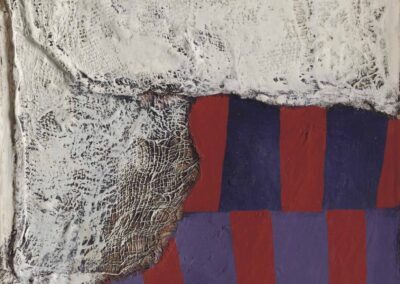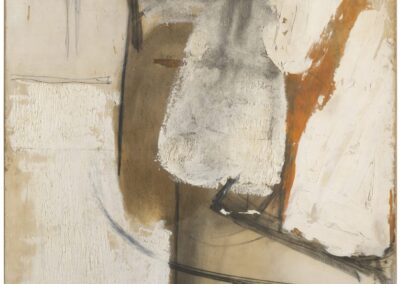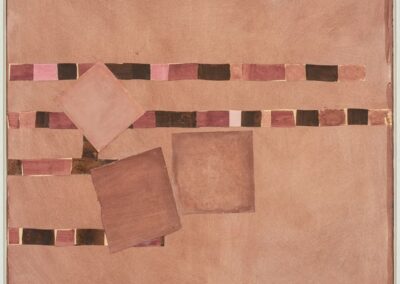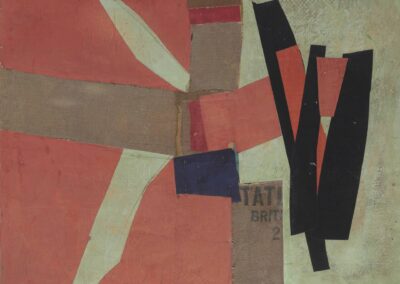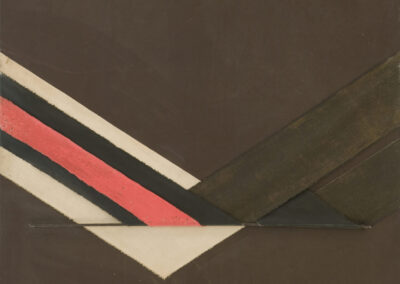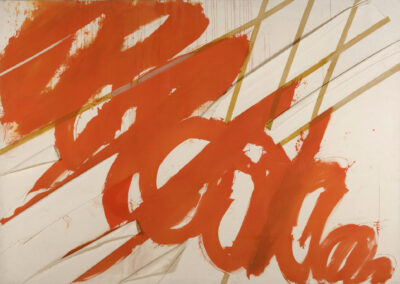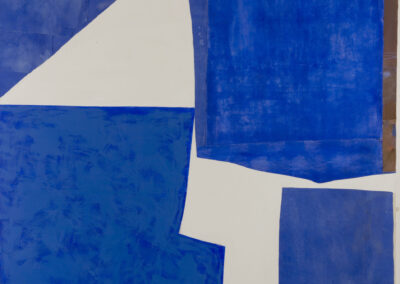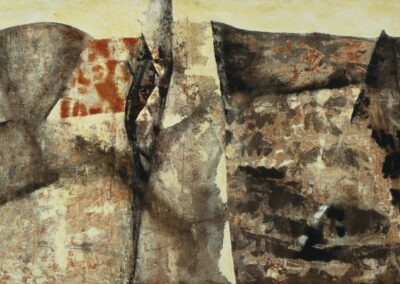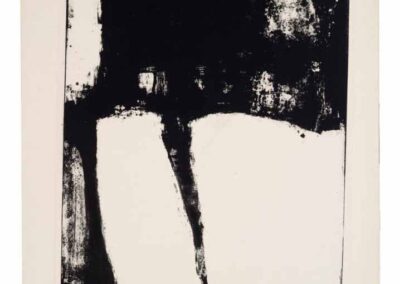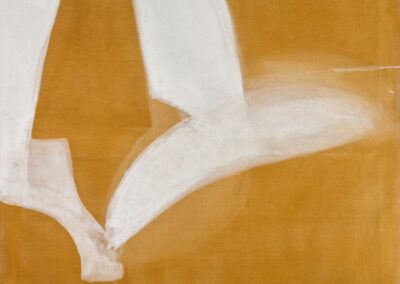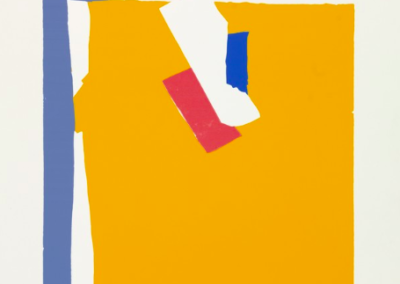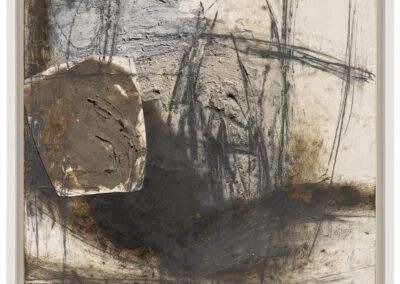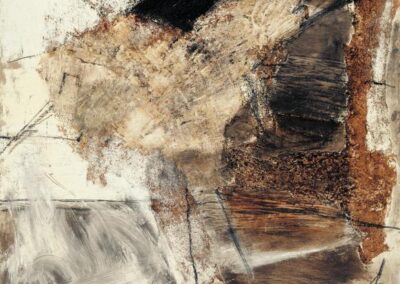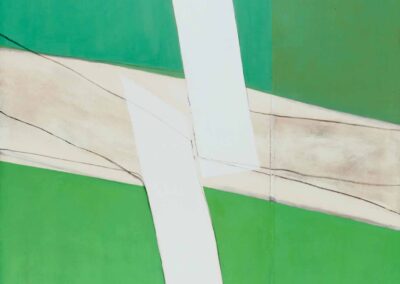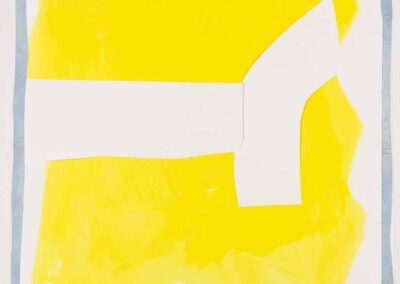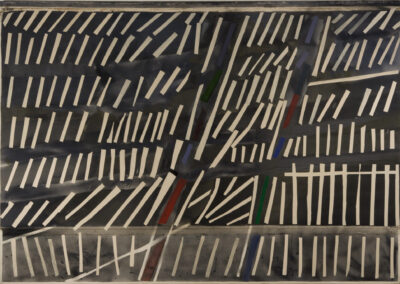Our next Artist You Need To Know is Sandra Blow, R.A. (1925 – 2006).
Blow was a trailblazing artist in the British abstract movement of the 1950s and 1960s who “stands alone as the earliest and most original woman painter in Britain able to challenge the bar-room “macho” cult associated with free, informal abstract painting.” (artist and writer Peter Davies, from here).
The majority of her works were very large scale, vibrant in colour and employed collage elements of discarded materials (one of her most famous works incorporated a mix of liquid cement and tar), engaging viewers in a manner that was both visual and tactile. “The balancing of proportion, tension and scale [were a major] part of her pictorial concerns.” (from AWARE)
The daughter of a fruit vendor, Blow left school at 14 : she then studied at Saint Martin’s School of Art (1941-1946) and then later at the Royal Academy Schools (1946-1947). Blow was also enrolled at the Accademia di Belle Arti in Rome : she met Alberto Burri there, and they would begin a relationship (both would pioneer paintings with ‘base’ found materials, through their careers) as they travelled in Italy and Spain together before moving to and working in Paris.
Blow frequently showed her work – through the 1950s and early 1960s – with Gimpel Fils : this major London (UK) gallery featured many St. Ives artists like Barbara Hepworth and Ben Nicholson. This association played a role in Blow’s relocation in 1957 to Zennor near St Ives, where she lived and worked for a year. In 1957 she featured in the first John Moores biannual exhibition at National Museums Liverpool and was included in the Young Artists Section at the Venice Biennale in 1958. Blow won the International Guggenheim Award in 1960.
She was also widely exhibited internationally during this period : she was frequently included in exhibitions of contemporary British art in places including Italy, Holland, Germany, the United States and later Australasia.
The artist and writer Peter Davies offers the following about Blow’s work : “During the 1950s, Sandra Blow was one of the pioneering abstract painters who introduced into British art a new expressive informality, using cheap, discarded materials such as sawdust, sackcloth and plaster alongside the more familiar material of paint. A tactile as well as visual emphasis on surface resulted in powerful and complex images, exuding a rooted earthiness, yet full of mysterious flux and ambiguity. Later, in response to the optimistic climate of the 1960s, Blow’s palette lightened and for most of the rest of her career, easily manipulated collage materials, like torn paper or brightly coloured canvas cut-outs, littered her often large-scale pictures.” (from here)
Blow would continue to modify and grow her style : she collaborated with architect Eric Defty in the 1970s. This body of work resulted in a number of paintings that would “incorporate geometric shapes among her organic forms…and turn increasingly to square canvases as an architectural component of her work.” (from here)
Blow was also a teacher : beginning In 1961 she taught at RCA for 14 years (among her students at the Royal College of Art at this time were David Hockney and R.B. Kitaj). The RCA would also host a major retrospective of her artwork in the 1990s. In the mid 1990s, Blow would relocate to St Ives : in many ways, her presence in the community as a significant respected artist was instrumental in “reinvigorating a Cornish art scene bereft of the glories she had sampled 35 years before.” (Peter Davies, again)
In her role as an RA (Royal Academician), Blow had artwork in every Summer Exhibition at Burlington House : a retrospective would be mounted there in 1994 (in the Sackler Galleries). An exhibition to mark Blow’s 80th birthday was held at Tate Britain, coinciding with the publication of a biography, Sandra Blow, by Michael Bird.
Sandra Blow passed away in 2006, from complications from a heart valve replacement operation : she had what many critics described as a ‘late career invigoration’ that made her death even a greater loss. In an obituary in The Guardian, Michael McNay asserted that “Blow maintained that events in her personal life often affected the appearance of her painting, not, of course, in an illustrational way, but in the tensions and clashes of the jostling marks on the canvas. But she believed also that abstract art did not simply reach its own natural if small audience, but gained some of its validity by feeding back into the broader visual life of the nation as fashion and architecture and design.”
You can see more of Blow’s work here : there is also a fine feature on Sandra Blow at the AWARE (Archive of Women Artists Research & Exhibitions) site here.

